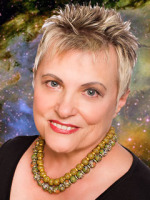
By Barbara Schermer
As long as I can remember I have been in love with the night sky.
My only memory of my Dutch-speaking grandmother Adolphine is her warning to me: “Pass op… Pass op!” she would say—watch out where you are going! Even as a toddler I was constantly in danger of tripping and falling because my eyes were always looking up.
They still do. The stars and planets have continued to draw me upward in a profoundly spiritual way. From a young age I came to know that organic life and the land’s harvest are strongly influenced by the moon’s phases. My grandfather, Cornelius, made his living by the Moon. He grew vegetables and flowers, which he delivered every morning by horse and wagon to the Fulton Street market on the South side of Chicago. When visiting him on Sundays I would tag along behind this kindhearted man as he worked along the furrows.
Grandpa swore by his trusted Farmer’s Almanac, a dogged-eared copy he kept hanging in the garden shed. He set out his tomato seedlings and his beloved Dahlias at the first quarter moon, sowed root vegetables during the waning moon, and planted his water-thirsty melons when the moon was in the water signs.
There is no word but “starstruck” to describe how I felt when I saw my first truly starry sky. I was ten when my family took a summer vacation to Saugatuck Michigan. A friend of the family, an astronomer from the University of Michigan, took us out to the beach to show us the summer constellations. I remember feeling a sense of delight when I learned that, moving above me, was the summer triangle of bright Vega, Aquila (the Eagle), and Deneb in the tail of the Swan Constellation who is forever flying south along the Milky Way. The idea that a swan flew over my head every summer—that the constellations proceded in orderly fashion across the sky with a consistent and reassuring rhythm—gave me an inexplicable sense of comfort.
I was California-bound after graduating from college. In San Francisco I met new friends in who soon revealed they were passionate about astrology. At parties they would stop speaking English and break into what to me sounded like a foreign language. “Well, your Mars made a trine to your Venus so, what did you expect?” Or, “Remember, Mercury goes retrograde on Friday so don’t buy that car yet.” I hadn’t a clue about these apparently meaningful exchanges. Astrology seemed like a secret language, yet one that had an intelligence that resonated in me. I was intrigued, so, like many of us stargazers, I began to gain knowledge of astrology by studying my own birth chart.
I learned that the ten planets, besides being bodies in the sky, are universal powers that exist in each of us—what depth-psychologists call archetypes, or universal principles—and that each planet travels through twelve signs and expresses itself differently in each, much as an actor shows different qualities when playing different characters. I learned also of the major planetary aspects, the energy dynamics that govern the relationships among planets as inner characters.
I closely watched transits, current planet positions in relationship to those of a birth chart, and found the symbolic meanings persuasive. I was especially impressed that so many astrologers warned John Kennedy against traveling to Dallas. As astrology revealed its mysteries, my ten year old sense of stellar awe quickened, and I have been a passionate practicing astrologer ever since.
As a society, we have lost track of our cosmic connections, what our forbearers knew from their living daily experience with the natural world. Our ancestors had an intimate relationship to the night sky, and their contemplation of the heavens was a vital, primal communion that brought meaning to life.
In fact, our ancestors very survival depended on someone having this star knowledge. In your own ancestral line there is a high likelihood that a member of your tribal family was an astrologer, priest or shaman who observed the heavens closely and knew when to successfully plant and harvest the crops that kept your community alive.
It’s a pity that most of us are cocooned in cities and that the streetlights keep us unaware of the wonder above us. Google the phrase “light pollution map” and you’ll see that Chicago, where I have lived for years, is one of the most densely light-polluted locations on the planet.
I love Chicago though, especially in the fall, when the trees have shaken off their leaves. I then get my first clear glimpse of Orion the winter “marker” constellation in the northern hemisphere and the brightest constellation in the heavens. On a clear night you can find Orion, called “the Hunter,” by looking for the three diagonal stars that mark his sword belt. If you look down just below his belt you will see three tiny stars aligned beneath. We can imagine they make up his sword. A close look will reveal one that is not sharp like a star, but fuzzy. You are seeing the Great Orion Nebula, a stellar nursery, one of the most prolific generators of new stars that we know.
Chicago in winter is less congenial to stargazing. So, for the last eleven years, I have spent weeks and then months in Mexico—at first at Rio Caliente spa in Mexico, an hour’s drive from Guadalajara, and now, with my husband Bob at our home on Lake Chapala.
I remember my many days and nights at Rio Caliente with deep affection. The spa (now closed for business—we hope for its return) rests in a 15,000 acre National Forest, surrounded on three sides by a river of volcanic lithium waters that feeds the blue-tiled pools. Days were a delight there, but my favorite times were at early dawn, between 3 and 5 am, while everyone else was sleeping. I would walk down to the pools in their private grove of high palms and flowering bougainvilleas—faded in the semidarkness from their daytime pink, white, and orange. I slipped into the steaming water carrying three plastic “noodles.” I put one under my neck to support my head and two under my knees to give my body buoyancy.
Then I just floated, suspended between heaven and Earth, among my familiars—Scorpio and its red supergiant star Antares, just risen, with Sagittarius not far behind, bringing the Teapot for morning tea, his arrow pointed toward the Galactic Center. Libra and Ophiucus and their attendant stars were already risen, Leo with Regulus and Virgo with Spica having nearly finished their passage across the sky. Again, I just floated, in touch with the ten-year-old who imagined herself hugging the Swan and gliding along the flowing river of the Milky Way.
That night sky is part of what brought me to Mexico to stay. While I no longer see it from the pools of Rio Caliente, most nights I can just step out onto myterraza, and look up to re-engage my childhood companions, my lifelong friends.
 Wednesday, September 14, 2011 at 4:22PM
Wednesday, September 14, 2011 at 4:22PM 




